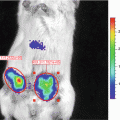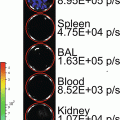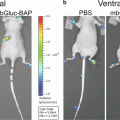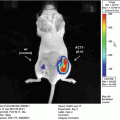(1)
Experimental Therapeutics and Molecular Imaging Laboratory, Neuroscience Center, Department of Neurology, Massachusetts General Hospital, Boston, MA, USA
(2)
Program in Neuroscience, Harvard Medical School, Boston, MA, USA
(3)
Experimental Therapeutics and Molecular Imaging Laboratory, Department of Neurology, Neuroscience Center, Massachusetts General Hospital, Boston, MA, USA
Abstract
Drug screening is an essential and widely used technique for drug discovery in various biomedical fields notably in oncology. Here we describe a functional screening assay based on the bioluminescence detection of a secreted luciferase for monitoring cell viability of cancer cells in a high-throughput format. This assay allows the screening of large libraries comprising thousands of compounds and the identification of potential anticancer molecules in a rapid, facile, and cost-effective manner.
Key words
ScreeningDrugsBioluminescenceGaussia luciferaseGlioblastoma1 Introduction
Identification of molecules with therapeutic benefit has become more accessible due to the availability of large libraries of chemical and natural products. While libraries comprising hundreds of thousands of compounds are now commercially available, drug discovery and development is still a laborious, expensive, and lengthy process. In an ideal setting, it starts with target identification, followed by compound screen eventually identifying a lead compound which will be optimized for efficacy and pharmacokinetics prior to translation into patients [1]. Methods to identify new drugs from compound libraries have become more accessible due to more affordable screening devices, larger libraries and the emerging of noninvasive techniques for faster and robust assay readout, such as bioluminescence imaging (BLI) [2].
Noninvasive molecular imaging of cultured cells and living animals has opened new avenues to help understand fundamental molecular and physiological processes [3]. BLI, in particular, became a widely used laboratory technique allowing the monitoring of different biological processes in immunology [4], oncology [5], virology [6] and neuroscience [7] among many other fields. BLI helps expedite the discovery as well as the development and optimization of new drugs [8]. The sensitive and relatively quick readout of photon emission allows screening for thousands of molecules in a labor, time, and cost-effective manner [9]. In fact, BLI has been widely used to screen thousands of compounds mostly in cell-based assays for target identification, gene signaling networks as well as protein–protein interaction [2, 10, 11]. This imaging modality is also suited for multiplexing with other genomic or proteomic assays for a multiparameter profiling of the complex cellular phenotype [12].
Recently, our group has developed a small-molecule drug screening assay based on the Gaussia luciferase (Gluc) [2]. When expressed under a constitutively active promoter, Gluc activity is linear with respect to time and cell number [2, 13]. The natural secretion properties of this luciferase and its high sensitivity as well as the time and cost effectiveness of bioluminescence imaging make this reporter an ideal readout for high-throughput screening [14]. Gluc activity can be measured either from aliquots of the conditioned medium for noninvasive longitudinal studies or directly from the luciferase-expressing cells in their medium.
Glioblastoma cells lines used in this screen were genetically engineered to stably express Gluc together with the Cyan Fluorescent Protein (CFP). Both Gluc and CFP are expressed in a lentivirus vector and the latter is used to assess the transduction efficiency. For our assay we used a constitutively active promoter driving Gluc to monitor cell viability. When investigating compounds that could affect gene expression or gene regulation instead of cell viability, the constitutively active promoter can be substituted with the inducible promoter of choice. These reporters typically consist of one or multiple transcription factors binding sites linked to a minimal promoter to drive the expression of a luciferase. Such bioluminescent reporters are often used in gene-targeted drug screening. In one example, a p53-reporter vector was used to identify small molecules affecting the transcriptional activation of this gene [15]. This screen identified compounds that activate p53 transcription.
It is important to note that while Gluc was our reporter of choice for this particular type of small-molecules screening, it could be replaced with other luciferases such as Firefly, Renilla, or Cypridina (also known as Vargula luciferase, Vluc). Luciferases that use different substrates can be combined together and used in multiplexed bioluminescence based assays.
In this chapter we describe all necessary steps needed to design and perform a compound-screening assay aimed to identify potential small molecules that kill glioblastoma cells.
2 Materials
2.1 Cell Culture
1.
U87 cells, American Type Culture Collection (ATCC) HTB-14.
2.
Complete medium: Dulbecco’s Modified Eagle Medium (DMEM), Fetal Calf Serum 10 %, 100 U Penicillin and 0.1 mg/mL Streptomycin (Pen/Strep).
3.
Phosphate Buffered Saline (PBS), sterile.
4.
0.05 % Trypsin/Ethylenediaminetetraacetic acid (EDTA) 1×.
5.
A 37 °C, CO2 regulated incubator.
2.2 Lentivirus Vector Transfection
1.
2 M Calcium Chloride (CaCl2).
2.
2.5 mM 4-(2-hydroxyethyl)-1-piperazineethanesulfonic acid (HEPES).
4.
Plasmids for lentivirus packaging:
(a)
(b)
Cytomegalovirus (CMV) ΔR8.91 (>0.5 μg/μL, Lentivirus).
(c)
Vesicular Stomatitis Virus Glycoprotein (VSVG).
5.
15 cm cell culture plates.
6.
SW32 Ti Rotor for ultracentrifugation (optional, for concentrating the lentivirus).
7.
293T cells, American Type Culture Collection (ATCC) CRL-11268 (for lentivirus packaging).
8.
Reduced Serum Medium, modification of Eagle’s Minimum Essential Medium (Opti-MEM) with Pen/Strep.
9.
Syringe filters, 0.45 μM.
10.
Polybrene (hexadimethrine bromide).
2.3 Compounds Screening
2.
384-Well Optical Bottom Plates.
3.
Coelenterazine (CTZ), substrate of Gaussia Luciferase enzyme.
4.
Dimethyl sulfoxide (DMSO).
5.
Temozolomide (TMZ).
6.
Tris buffer (30 nM), pH 8.0.
7.
Triton X-100.
8.
Orbitor RS Microplate Mover (Thermo Scientific).
9.
Multidrop Combi (Thermo Scientific), for the dispensing of liquids and shaking plates.
10.
Luminometer or a plate reader capable of measuring luminescence. In our case we used the Flexstation 3 (Molecular Devices).
11.
Momentum Software, for managing and running the Orbitor RS Microplate Mover, Multidrop Combi, and Flexstation 3 in a fully automated manner.
12.
Softmax 5.4 software, for bioluminescence data acquisition and analysis.
13.
Multichannel pipettes (for manual screen, see Note 4). A fixed or adjustable 8- or 12-channel pipette can be use to pipet into a 384-well plate. The multichannel pipettes used should cover a range of 1–100 μL.
3 Methods
3.1 Propagation of Glioblastoma Cells
1.
U87 cells are grown in a T75 flask.
2.
Aspirate cell culture medium.
3.
Wash cells once with 5 mL of PBS.
4.
Aspirate PBS.
5.
Trypsinize cells with 1 mL (5 min, 37 °C), and then add 3 mL of complete medium to stop the reaction.
6.
Detach the remaining attached cells from the flash by pipetting up and down. Collect them at the bottom of the flask and transfer them to a 50 mL tube.
7.
Centrifuge cells at 400 × g for 5 min.
8.
Aspirate medium and resuspend the pellet with 1 mL of complete medium.
9.
After counting, plate 1 × 106 cells in a T75 flask.
10.
Repeat this routine every 2 days (80 % of confluence).
3.2 Lentivirus Vector Transfection
1.
Day 1: Plate 21 × 106 293T cells in a 150 × 25 mm dish using complete medium.
2.
Get Clinical Tree app for offline access

Day 2: Replace medium 2 h before transfection with fresh complete medium.
(a)




Prepare transfection mix:
Vial 1: 18 μg pCSCW-Gluc-IRES-CFP vector, 18 μg CMVΔR8.91, 12 μg VSVG, 96.0 μL 2 M CaCl2, up to 780 μL 2.5 mM HEPES.
Stay updated, free articles. Join our Telegram channel

Full access? Get Clinical Tree








